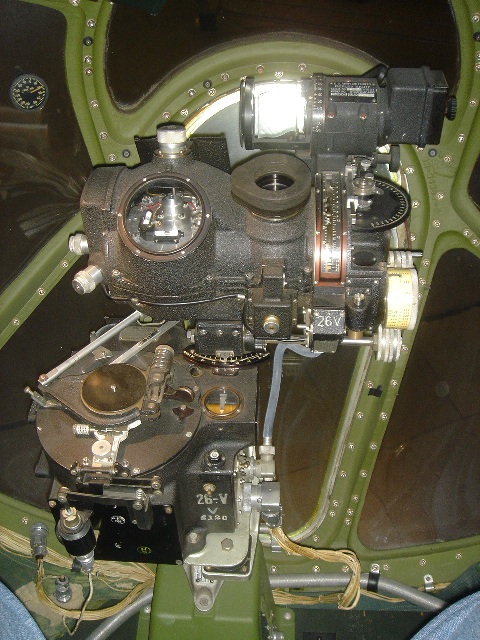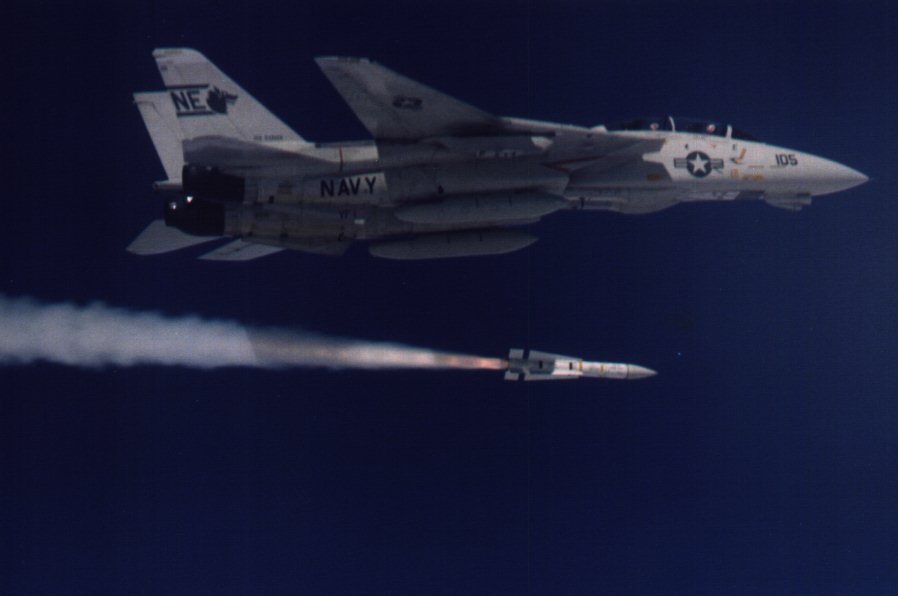A Journey into History – Part VII
March 30th, 2006 by xformed
Part I, Part II, Part III,Part IV, Part V, Part VI, Part VIII
It was the early morning hours of March 25th at this point (around 0200) and there we were, the entire staff and almost all the augmentees, standing there in our watchstation on the Flag Bridge. I believe it was the 07 Level on the carrier’s island. All around us were the nominal things used to stand the watch: Notebooks, pens, pencils, dividers, parallel dividers, magic markers, tactical publications, message boards, and, don’t forget the coffee cups and Coke cans. These things, as some of you readers know, have another, more generic name: Missile Hazards. More on that in a moment.
In theory, the pair of Soviet built OSA missile patrol boats headed towards us “AT HIGH SPEED!” were each loaded with 4 SSN-2 STYX cruise missiles. In new math, that means 8 near supersonic, with a flight profile low to the water, weapons may be announced with the proword “VAMPIRES” any moment. Back to the missile hazards. Steve Nerheim was at one side of the chart table, and I was at the other. I recall I looked at Steve, and he had a wild-eyed look in his eyes, just before (and simultaneously with me) his hand grabbed for the latch on the top drawer of the chart table and proceeded (aided by my hand at the other hand on the other latch) to slam the drawer wide open, whereupon we both yelled “MISSILE HAZARDS!” and began sweeping every loose thing from the chart table top into the drawer. After that we grabbed and stuffed every thing in sight into that drawer, and then got to getting ourselves into battle dress.
The concepts of missile hazards and battle dress are generally introduced to most naval personnel during the endless days of “REFTRA” (refresher training), which used to be held at Naval Station, Guantanamo Bay, Cuba, a place more often (and oh, so lovingly) just called “GTMO” (pronounced “git-mo”). The many and varied stories (of the same incidences in some cases) would fill screen after screen after screen on blogs by the hundreds, but almost all of them would mention something about missile hazards or battle dress. Missile hazards, as deemed by common sense, once you get by the fact the GTMO Fleet Training Group (FTG) sailors were “making you do it,” is anything that the force of a close by explosion may be able to impart enough energy into it so as to damage the human contents of the surrounding vicinity of said missile hazard. You come to hate the thought of dealing with the lost point for things like the “left behind” paper clip the FTG guy is holding in your face just before the ship is cleared for getting underway for the day’s training, with that “I just nailed you for one more point off your exercise score, buddy!” look on his face, but after a few weeks, you begin to unconsciously scan your vicinity constantly for loose items. It’s bad enough to get nailed at the beginning of the day, but more irritating when you use some object, such as the dividers to measure something on a chart, and then carelessly put them down on the chart, and, as luck normally has it, right under the nose of the exercise observer, who, once more, smiles and lifts his clip board to make a note about another point off.
That being said, when real, high speed ordnance may be in your future “real soon now,” you immediately recall the laws of physics, and some rudimentary biology that says that coffee cup over there is gonna leave a mark if I leave it sitting on the frame stringer just behind the chart table. It’s sort of like Steve and I, having served in different commands to get where we were, “got religion” on the topic when this scenario presented itself.
Battle dress is the other thing sailors love to hate and do just about anything to justify not reconfiguring their clothing in order to satisfy the little tyrants the FTG guys seem to be. Battle dress amounts to a real fashion statement. Consider the well dressed (for work) sailor, chief or officer (not in the new BDU knock off stuff) with the bottom of the bell bottom or khaki trousers stuffed into their black socks above their shoes, the normally open shirt collar buttoned all the way to the top, and the long sleeves rolled down and the cuffs buttoned. It does look very strange, and, once again, when you consider the purpose, it is something meant to keep the exposed skin to the absolute minimum. In the in most every training scenario, the outfitting also meant scrambling for the locker in the space that held the gas mask bags, each one normally labeled for the crew member it was issued to/fitted for. Picture strange shaped olive green or medium grey footballs with waist straps flying across the space as someone answers up to the name just read off the stenciling. In the late 80’s, we adopted the crew wide issuing of anti-flash gear, which included opera length gloves and a pull over hood, with the open hole for your eyes and nose to be exposed though.
I’ll admit, I missed out completely on the opportunity that most every other service member experiences: The tear gas chamber. I was in GTMO for refresher training in early 1985, while assigned to USS CONOLLY (DD-979). We were going to be import for the weekend, but the Saturday morning schedule had most of the crew set to attend this wonderful opportunity to appreciate the wonders of low level chemical warfare. On Friday evening, they sent us a schedule change that sent us to the base school auditorium instead. Our training involved listening to a Royal Navy LT, who was currently assigned on an exchange tour with Fleet Combat Training Center, Atlantic as a Tactical Action Officer (TAO) course instructor. That assignment was not the basis of his talk that day. He spent several hours talking about his experiences in the Falklands War. He had been the Weapons Officer on one of the destroyers that was hit with and sunk by an Exocet cruise missile. He had been rescued and then was aboard the frigate that had had an Argentinean dumb bomb, unexploded, lodged in the engine room that exploded when the EOD technicians were attempting to safe it. That ship sunk also. As you might imagine, despite the significant exhaustion that GTMO instills, no one was sleeping in the gym that day.
He talked about the effectiveness of anti-flash gear in various parts of the presentation. He said you could tell those who did not like to wear it and had pulled the lower part of the flash hood hole down under their chins. He said when the fireball caused by the unused fuel of the cruise missile ignited and swept through a space, those with exposed skin bore the damage, from surrogate sun burns to significant burns all over their face. He also discussed another physics topic, which was about the property of colors to transmit heat. One ship’s commanding officer had labeled his flash hood with “CO” on black magic marker on the forehead area of the hood. Despite wearing the hood properly, that captain will forever go through life with “CO†burned into his skin, in the same manner that the colored patterns of the kimonos the Japanese women were wearing during the atomic bombs dropped caused their skin to be marked where the darker colors in the fabric patterns was. That part of his story stayed with me to the end of may sea time.
While the brief moments of time were passing in that watch station, with everyone kicking into GTMO muscle memory mode, the SARATOGA Surface module crew ordered the airborne SUCAP (Surface Combat Action Patrol) to intercept the OSA boats. We had the ASUW circuit up in one of our many speakers and I remember the section A-6 lead calling asking if the ship was sure there were OSA boats out there, for the area where he was sent did have a ship, but he said it “had a lot of lights on it.” That reminded me that before the cruise, I remember there had been a push to make sure the Air Wing A-6 assets where equipped with TRAM pods. These “pods” were multi-function sensors mounted beneath the radome of the aircraft, and they were articulated to allow the aircrew to steer the cameras and laser designators around. Included in the sensors was low light level television. The section leader of the SUCAP, despite the urging of the ASUW talker to engage the targets with Harpoon, spent a few extra moments using the available tools to ensure he was doing the right thing. What he reported back was he was breaking off the attack because it wasn’t OSA boats, but a cruise liner, with all sorts of deck lights on, and it was doing 16 knots, not 42. Moral of the story: Make sure everyone has their heads in the game, and you’ll not make stupid mistakes that cause nations to have to apologize to most of the citizens of the world for engaging a “white” (neutral) target in the fog of war.
And this ends my recollection of the events of March 24th and 25th in 1986, in the central Ionian Sea, aboard the flagship for Battle Force ZULU. It is not, however, the end of the tale of the beginning of the offensive phase of the GWoT.
Category: Air Force, Geo-Political, History, Jointness, Military, Military History, Navy, Political | 2 Comments »










